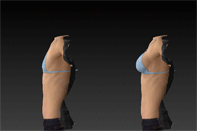Teardrop breast implants are an alternative to round breast implants. Many women opt for teardrop implants due to their more natural look and feel vs. the round implants that have been the staple of plastic surgeons for many years.
They come in several brands such as: Mentor, Allergan and Silimed. Despite the marketing hype, whichever major brand you choose is just as good as the other. Each plastic surgeon has his/her favorite brand that has worked well for them (and their patients) over the years.
Originally designed for women who needed reconstructive breast surgery, tear drop breast implants were recently approved for use in America by the FDA in 2012. Prior to that, they were only available in many parts of Europe and select medical study centers.
As the years went by, more and more women opted for a more natural look and feel vs. the traditional high cleavage round implants that have become synonymous with the word “breast implants”.
Why are They Called Teardrop Breast Implants?
Teardrop breast implants are aptly named because they resemble a human tear. The teardrop breast shape has a wide, round base that gently slopes upward, giving a more natural appearance. They are designed to maintain their shape and are sometimes referred to as “Gummy drop” or “Form-stable”. A different way to describe it would be to think of a piece of memory foam. As you press on it, it naturally depresses. When you release pressure, the memory foam reverts to its original shape.
They are also designed in a wide variety of shapes. While the general profile is that of a teardrop, you can find ones that have a “tall” profile and a “wide” profile. The reason for this is that one size does not fit all. Women’s bodies are unique and as such the surgeon will make a recommendation as to which profile/implant will look right on your body. Ultimately, the final decision lies in your hands.
What Benefits Do Teardrop Breast Implants Have?
Teardrop breast implants were originally intended for women who were looking to have reconstructive breast surgery, but after a few years more and more women started opting for the teardrop look vs. the older “rounded” look. At the end of the day, you’re probably going to get less attention (from both men and women) if you opt for teardrops over rounded implants.
Teardrops are also great for women who have very little breast tissue to begin with due to the fact that shaped implants (teardrops) help define the shape of the breast without creating the unnatural looking round shape that’s a telltale sign of older implants.
They are also good if the nipple on the breast is in a position that is lower than ideal, and the person wants to improve the nipple position without undergoing a breast lift.
Aside from coming in many different sizes and shapes, teardrops also come with one of two kinds of fills: Saline and Silicone. Each has its own benefits:
Types of Fill for Teardrop Breast Implants
Saline
- Requires smaller incision than it would for a silicon implant of the same size.
- Generally speaking, saline implants tend to cost less than silicon.
- If a saline implant breaks or ruptures, it will be completely harmless. The size and shape of the breast will instantly deflate, and it will be very noticeable that there is a problem (and you should call the doctor ASAP).
- Saline implants have a flexible fill volume that the doctor can adjust according to aesthetics as well as the shape/size that you desire.
Silicone
- Implants are filled with a very thick gel, that holds shape and gives off the feel of real breast tissue.
- Silicone implants tend to have less wrinkles and rippling than saline ones.
- If silicone implants rupture, the breast will retain its natural shape and no gel will be spilled out into the body.
- These kinds of implants have a standard fill volume for predictable results. What you see is what you get.
I Want Teardrop Breasts! Now What?
First you need to schedule an appointment with your doctor. Keep in mind that while teardrop breasts are meant for a more natural look, they’re probably not going to be as noticeable as rounded ones are (due to the lack of cleavage on a teardrop vs. round implant). They also tend to cost a bit more than the rounded ones.
When you talk with your surgeon, be sure to ask as many questions as you can. You can never ask too many questions regarding the type of implants you choose.
Teardrop breast implants are also more technically challenging for the surgeon and the end result can be highly contingent upon the skill of the surgeon. They can be hard to place in the right area for a natural look. If you choose an experienced plastic surgeon, you can feel confident that you will be happy and satisfied with how your new breasts look.
Frequently Asked Questions about Teardrop Breasts
Are there any specific situations or body types where teardrop implants are more suitable than round implants?
Teardrop implants are often recommended for women who have less breast tissue or who are looking for a more subtle enhancement. They can also be a good option for women who want to correct asymmetry or restore breast shape after pregnancy or weight loss.
Are there any potential risks or complications associated with teardrop breast?
Like any surgical procedure, breast augmentation with teardrop implants carries risks such as infection, bleeding, and changes in nipple sensation. There is also a risk of the implant rotating or shifting position, which may require additional surgery to correct.
In the hands of a skilled surgeon, there should be little to no complications as long as post-op instructions are followed.
How is the surgical procedure for teardrop implants different from that of round implants?
The surgical procedure for teardrop implants is similar to that of round implants, involving incisions, placement of the implant, and closure of the incisions. However, the shape of the implant requires careful positioning to ensure a natural-looking result.
What is the recovery process like for teardrop implants, and are there any special considerations compared to round implants?
The recovery process for teardrop implants will involve some discomfort, swelling, and bruising. Patients are usually advised to avoid strenuous activities and to wear a supportive bra to help with healing.
Your doctor will provide post-op instructions to follow as your body heals from the surgery. There should be no difference in the recovery from teardrop breast implants when compared to traditional round implants.
Can teardrop implants provide a more natural-looking result than round implants, especially for women with less breast tissue?
Yes, teardrop implants are often recommended for women with less breast tissue or those looking for a more natural-looking result. The teardrop shape can help create a gentle slope and a more natural contour, which may be preferred by some women over the round, more noticeable look of round implants.
How long do teardrop implants typically last, and are there any maintenance or follow-up procedures required?
Teardrop implants are designed to be long-lasting, but like any breast implant, they may need to be replaced or removed at some point due to complications or changes in the breast tissue. Regular follow-up appointments with your plastic surgeon are recommended to monitor the implants and ensure they are functioning properly.
Are there any specific activities or lifestyle factors that could impact the suitability or longevity of teardrop implants compared to round implants?
While teardrop implants are designed to provide a more natural-looking result, they may be more prone to rotation or shifting position compared to round implants. Patients are advised to avoid activities that put pressure on the breasts, such as heavy lifting or strenuous exercise, to reduce the risk of complications.















